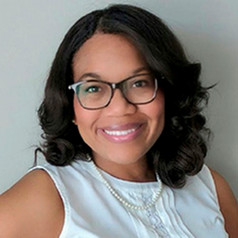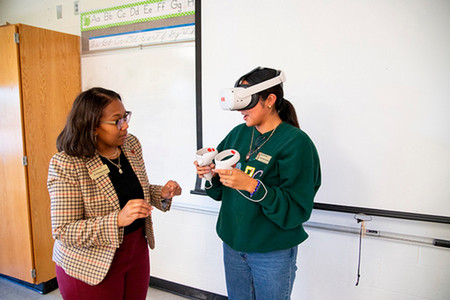Q: What led you to try this approach?
A: STEM jobs are expected to grow 10.8% between 2022 and 2032, almost four times faster than non-STEM jobs. And the U.S. will need to fill about 3.5 million jobs by 2025. This is significant! We will not be able to fill these jobs tomorrow if we do not have young people interested and connected to STEM today!
As a culturally relevant science educator and researcher, I am committed to broadening participation in STEM for underrepresented communities. My current project focuses on early elementary school students. With so much buzz around virtual and augmented reality, I wanted to create an authentic, culturally relevant learning experience to increase our youngest learners' interest in and connection to science.
VR is an immersive learning experience where students can explore complex concepts in highly interactive ways, and it can also allow students to center their own culture and communities, where they see themselves and others like them represented.
A: As a science educator, I am piloting this work with pre-service teachers, who will then deploy their learning and designs in the field with 5th graders at a local elementary school. Together, we are exploring whether using VR technology in the science classroom will prove meaningful and beneficial to student learning and engagement.
My goal is two-fold: I hope the pre-service teachers gain comfort and confidence with the VR platform and with designing experiences that help broaden STEM participation among their students. I also hope the elementary students really embrace VR learning and come away from the experience with greater motivation, interest in, and knowledge of science/STEM.
A: This project has substantially changed my approach to teaching and learning. When I embarked on this journey in March 2024, I worked with the Advanced Visualization Lab to develop a plan and tool for fall 2024. However, this plan was turned entirely on its head in July 2024 when I received word that I would have a blind student enrolled in the course.
I remember asking myself how I could create a VR learning experience that was both accessible and impactful for someone who is blind. In re-constructing and co-designing with the blind student, I have been able to look across the entire course and incorporate changes that create a more inclusive and accessible VR experience for all students.
I also encountered unexpected technical obstacles at the elementary school where the teaching and learning are taking place. The local district and elementary school have strict web censorship policies (rightfully so to keep kids safe), and the VR platform we are using to create, design, and deploy our culturally relevant VR lessons is being blocked by the school's firewall. I have worked tirelessly with school administrators and district IT support to resolve the issue. In the meantime, my design team and I have developed a workaround.
A: When I first applied for the ACI Fellowship, I wasn't sure if my project proposal met the award's criteria. I reached out, shared my ideas, and decided to apply! Fast-forward eight months, and I am piloting that very proposal with the help and support of the Advanced Visualization Laboratory and the University Library Virtual Reality Lab. Their expertise has been instrumental in developing and deploying the project and dealing with unanticipated situations along the way.
The pre-service teachers are currently designing scenes and environments using Spatial.io, which the 5th-grade students will experience with the VR headsets. Because this tool and technology are new not only to the 5th-grade students but also to the pre-service teachers, the pre-service teachers used the first two weeks of the course to explore the VR headsets, set up their Spatial.io accounts, and practice designing and importing content.
This project is a work in progress and will conclude with a culminating project where pre-service teachers create a culturally relevant VR science lesson around K-6 Indiana Academic Science Standards. I am really excited about this work and look forward to sharing more at the end of the semester!





